Wondering which tool is right for you?
When choosing a marketing automation platform, there are a handful of features you expect to encounter. Namely, an intuitive automation builder for users of all levels, advanced email marketing features that make building campaigns easy, CRM functionality, and lead generation tools like landing pages, forms, and pop-ups.
Both ActiveCampaign and GetResponse are well-loved platforms among marketers around the world. The reality is that you’re choosing between a tool that offers advanced automation and email marketing features and a platform with basic features for those who don’t need to build complex automations and engage customers on multiple channels.
Let’s take a look at the features these platforms offer, who they’re best for, what they’ll cost you, and help you select the one that’s right for you.
ActiveCampaign: features that let you do more
ActiveCampaign was founded in 2003 and originally focused on email marketing automation for small businesses. Over time, it grew into a more sophisticated platform, incorporating CRM (customer relationship management) features and advanced automation tools. Today, it’s known for being a comprehensive marketing automation platform that combines email marketing, sales automation, and customer experience tools.
The platform is particularly recognized for its advanced automation features, including its visual automation builder, dynamic content personalization, and advanced segmentation. It also offers tools for A/B testing, sales pipelines, and detailed reporting, which make it ideal for users looking to create highly targeted and personalized campaigns.
| 93.4% deliverability rate | 250+ email templates |
|---|---|
| 970+ integrations | 10k monthly sends on Starter plan |
ActiveCampaign is a great fit for both small and large businesses because it offers the tools you need without overwhelming you with unnecessary extras. The platform is best suited for businesses that need scalable, data-driven solutions with sophisticated automation.
When you switch from to ActiveCampaign, enjoy free 1:1 migration
Adopting a new or switching to another platform can be an undertaking, but it’s inevitable if you’re hitting certain limits with your current tool. When you sign up for an ActiveCampaign Pro or Enterprise plan, we’ll migrate your email lists, transfer your templates, rebuild your automations, and set up your forms and landing pages. All for free.
You’ll get one-on-one sessions with a real person along with resources like help articles and our community to get you set up fast.
GetResponse: beginner-friendly features
GetResponse is an all-in-one marketing platform built to help businesses grow their online presence with tools for email marketing, automation, webinars, and a basic CRM. It’s designed to be beginner-friendly while still offering features that can scale as your business grows, making it a versatile option for various needs.
| 89.7% deliverability rate | 150+ email templates |
|---|---|
| 185 integrations | Unlimited monthly sends on Email Marketing plan |
One of GetResponse’s standout features is its webinar tool, which is rare among email marketing platforms. This, combined with tools for building landing pages, creating automated workflows, and managing contacts, makes it especially useful for small businesses and solopreneurs who want an easy way to manage marketing without juggling multiple platforms.
Overall, GetResponse is a great choice for businesses that want an affordable, easy-to-use platform with solid tools for email marketing and lead generation, plus a few extras to stand out.
How do ActiveCampaign and GetResponse compare?
Naturally, ActiveCampaign and GetResponse have some key differences. Let’s look at how EmailTooltester rated each platform across a range of features.
| ActiveCampaign | GetResponse | |
|---|---|---|
| Email marketing automation | 5 stars | 4 stars |
| Editor | 5 stars | 4 stars |
| List management | 5 stars | 5 stars |
| Registration forms/opt-in and opt-out process | 5 stars | 4.5 stars |
| Deliverability | 4.5 stars | 4 stars |
| Reports and analysis | 4.5 stars | 4.5 stars |
| Spam and design testing | 3.5 stars | 5 stars |
| Customer support | 5 stars | 4 stars |
Source: EmailTooltester
EmailTooltester compared both platforms on things like ease of use, forms, website and landing page builders, marketing automation, CRM, reporting, and more in this video.
1st in deliverability vs. 5th place
What good is your email campaign if nobody sees it? From the past three deliverability tests EmailTooltester ran this year, ActiveCampaign scored first over all other platforms with a 93.4% deliverability rate. In comparison, GetResponse placed fifth with a deliverability rate of 89.7%.

During their test, EmailTooltester found that the average deliverability rate among the email service providers tested was 83.1%. That means 16.9% of all emails never reach their intended destination.
A better deliverability rate means more of your contacts will see the emails you send, increasing your chances of interaction (and hopefully conversion). ActiveCampaign is clearly the go-to email platform if you care about deliverability.
And you should, because an undelivered or lost to the spam folder email is practically useless.
Email builder: both platforms bring their ‘A’ game
Both ActiveCampaign and GetResponse have great email builders that allow you to create well-designed emails for your campaigns.
The ActiveCampaign email builder is known for its intuitive interface and customization options that make it easy to create polished, on-brand emails in minutes. You have access to a wide range of blocks, including:
- Image
- Text
- Button
- Spacer
- Video
- Social
- Banner
- Timer
- Menu
- And HTML for custom code
With their flexible, user-friendly drag-and-drop editor, you can easily design emails by dragging elements like text blocks, images, buttons, spacers, and dividers into your layout. Each element is customizable—you can adjust fonts, colors, sizes, and alignments to match your brand. For advanced users, there’s even an HTML editor for fine-tuning.

What makes it stand out is the seamless workflow: you can move elements around until everything looks perfect, preview changes in real-time, and undo or redo edits as needed.
ActiveCampaign also offers a library of over 250 pre-built templates with advanced editing options and the ability to save reusable content blocks. These templates are fully customizable, allowing users to adjust layouts, colors, fonts, and content to match their branding. The drag-and-drop email designer makes this process accessible, even for those with minimal design experience.
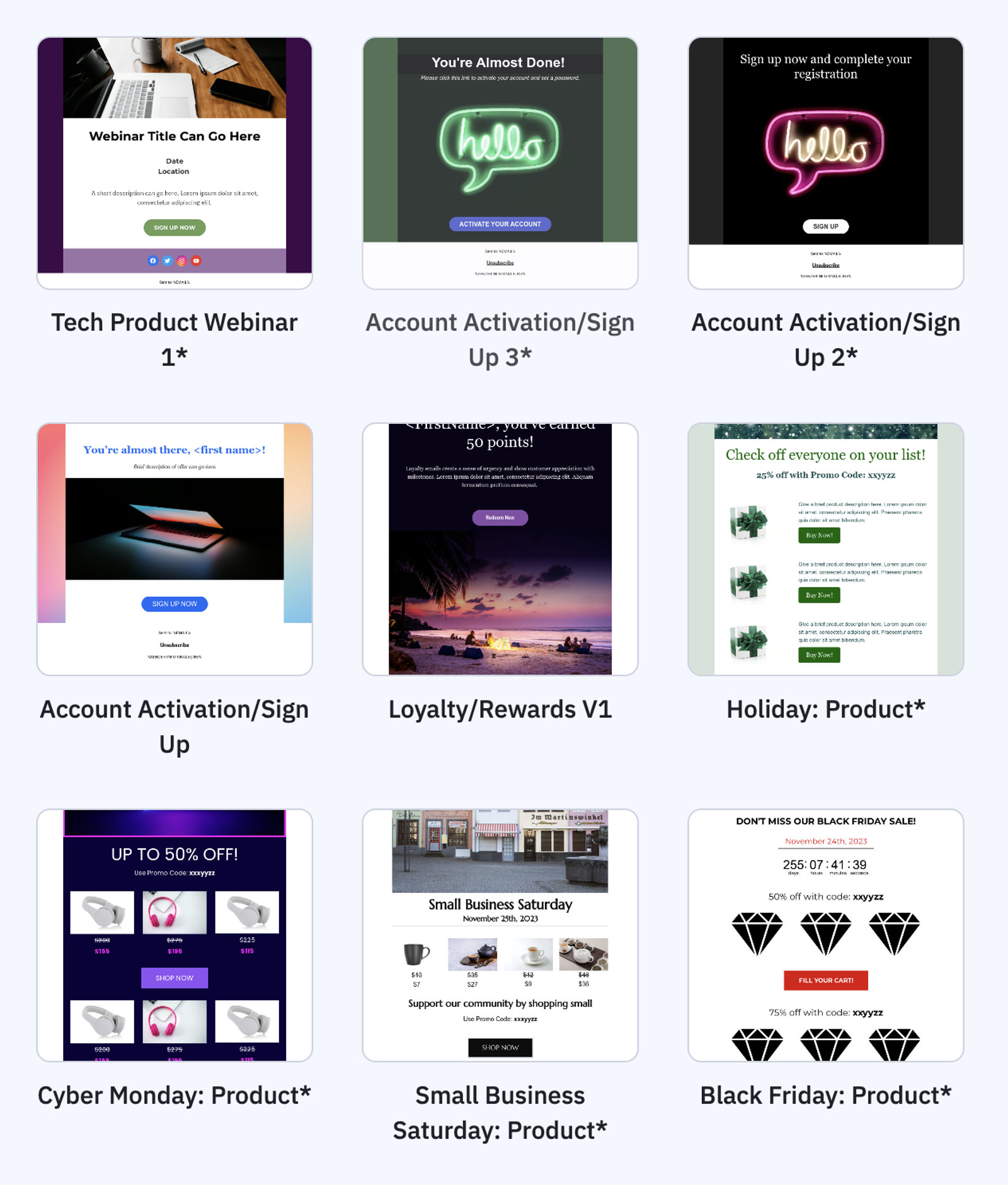
Plus, these templates can be tailored with conditional content, allowing more complex designs that adapt to each contact’s information. A/B testing is also possible.
GetResponse’s email builder is also pretty powerful, designed to create professional, eye-catching emails even if you don’t have design experience. With their drag-and-drop tool, you can easily move elements like text, images, and buttons into place. Save time with pre-made blocks for headers, footers, and content sections. These are ready to go and can be customized to fit your brand’s style.
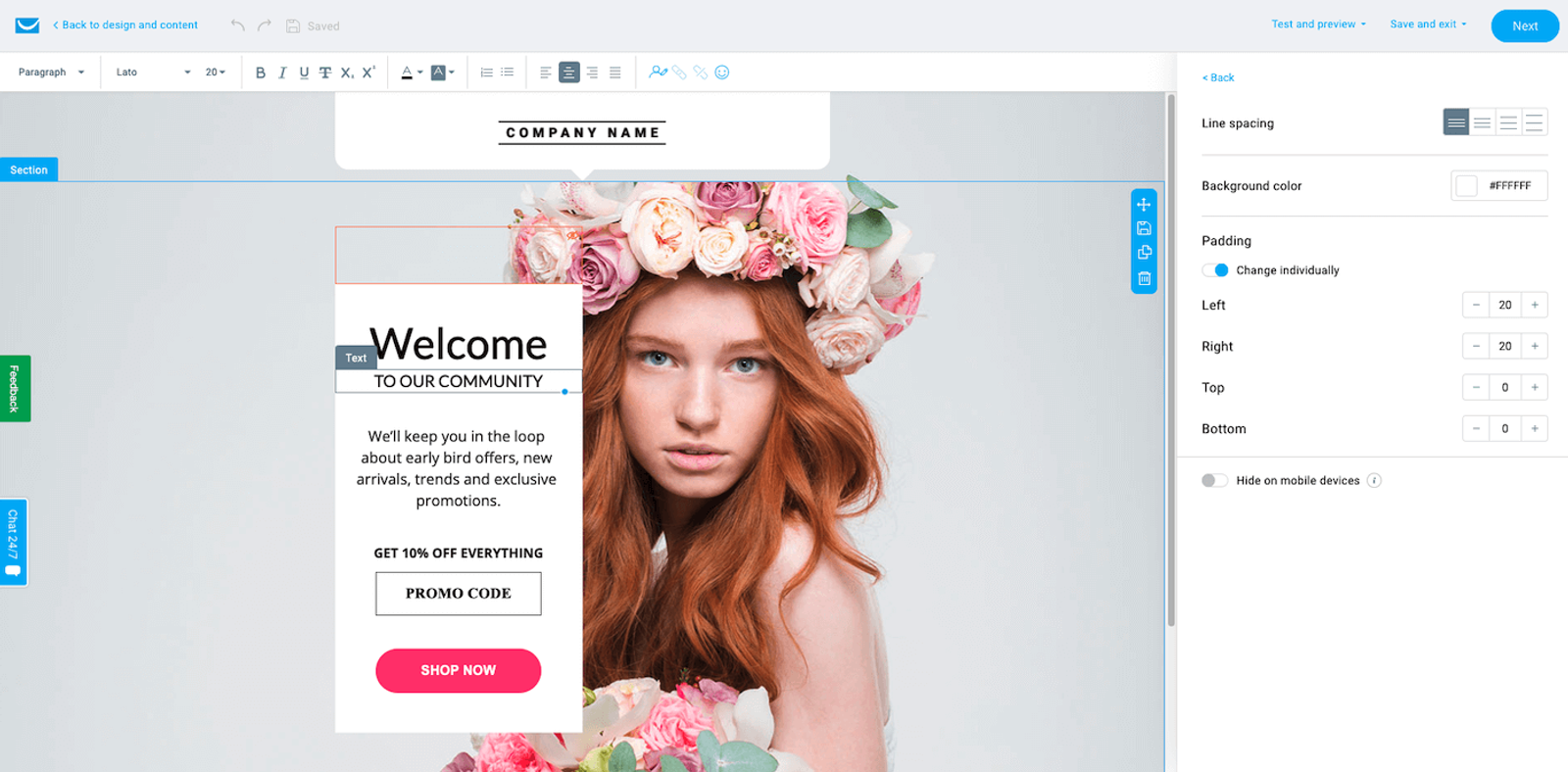
Plus, they offer a set of 150 pre-designed templates to give you a polished starting point. There are a variety of categories including business, education, events, holidays, and sales templates to fit different types of campaigns.

GetResponse also has interactive elements included in their email builder including countdown timers, video modules, and clickable buttons to make your emails more engaging for your audience. Plus, you can also create or add your own HTML templates with the HTML builder just like ActiveCampaign.
Every email you create is automatically mobile-friendly, allowing you to preview and tweak the mobile version to make sure it looks great on smaller screens.
Just like ActiveCampaign, GetResponse’s email builder is a good choice for anyone who wants to create beautiful, effective emails without the hassle of coding. Both platforms offer customization and the tools you need to craft beautiful emails.
Email marketing with deep customization vs. solid essentials
Solid and truly powerful email marketing features are likely a big deciding factor in which platform you choose. Luckily, both tools compete here with one key difference.
ActiveCampaign’s segmentation allows you to organize your audience into targeted groups based on behavior, location, purchase history, and more. This highly targeted approach to email lists is essential to send emails that match your audience’s interests and return much better results.
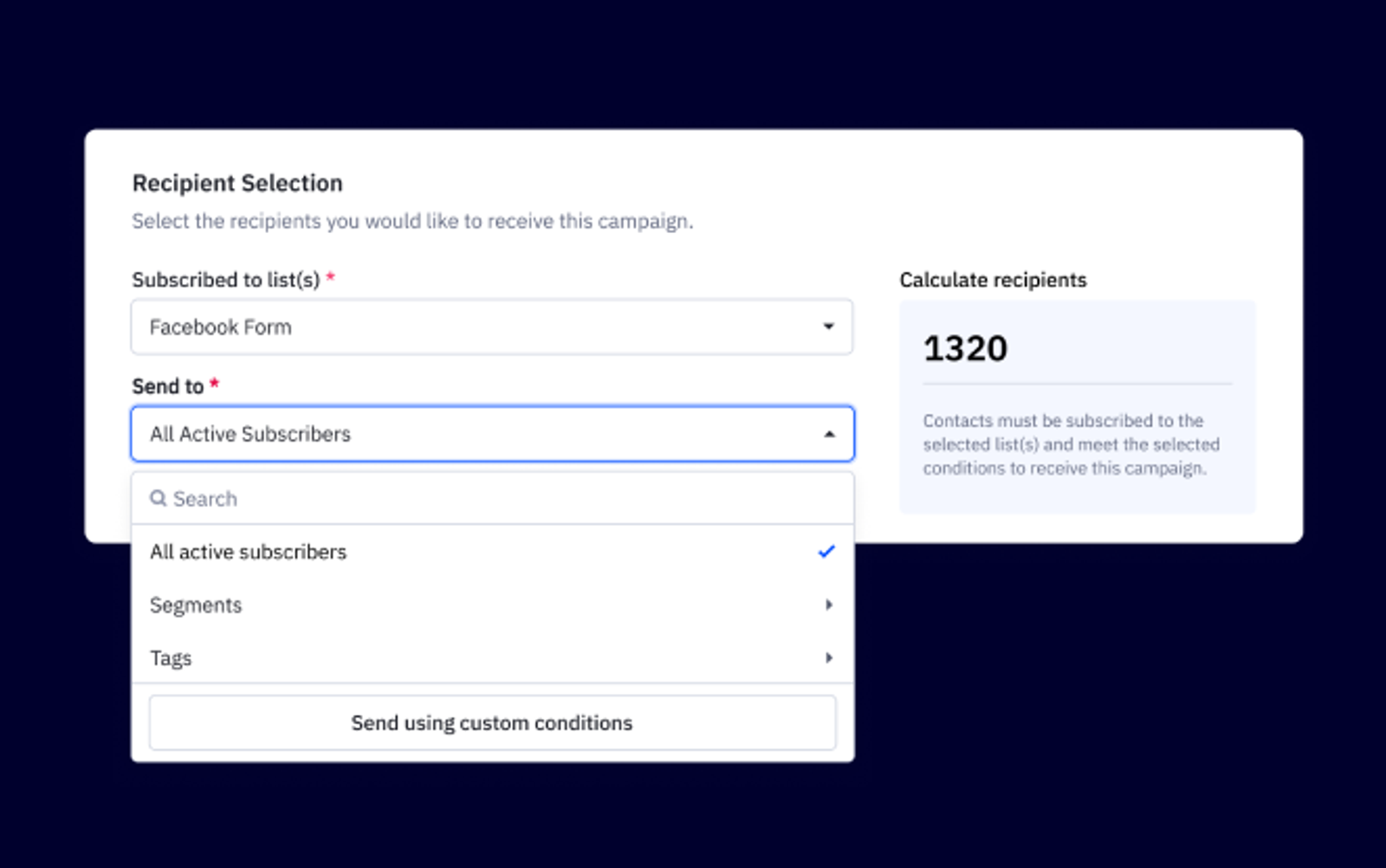
You can use advanced segmentation criteria like page visits, email engagement, and even lead scores, which means you can create specific segments and reach the right audience with precise messaging.
You’ll also get to use dynamic segments. These are lists that automatically update based on set criteria. For instance, you could create a segment of contacts who opened an email in the past month. This feature ensures that your lists are always relevant without constant manual updates. No more manually sorting through data to find the right people—dynamic segments do it for you, so you’re always sending to an up-to-date, engaged audience.
Tags allow you to label contacts based on specific characteristics or actions. You might tag contacts as “Newsletter Subscriber,” “VIP Customer,” or even “Webinar Attendee.” These tags are highly customizable and let you easily group contacts for targeted marketing.

ActiveCampaign also allows you to create custom fields that capture specific information about each contact, such as location, birthday, or preferences. You can then use this data to create more personalized messages. For example, you might create a custom field for “Favorite Product,” allowing you to tailor your emails around that specific interest.
Dynamic content lets you personalize specific sections of emails based on each contact’s details, behaviors, or tags. You can set up different sections of an email to show different content depending on the recipient’s interests, behavior, or tags.
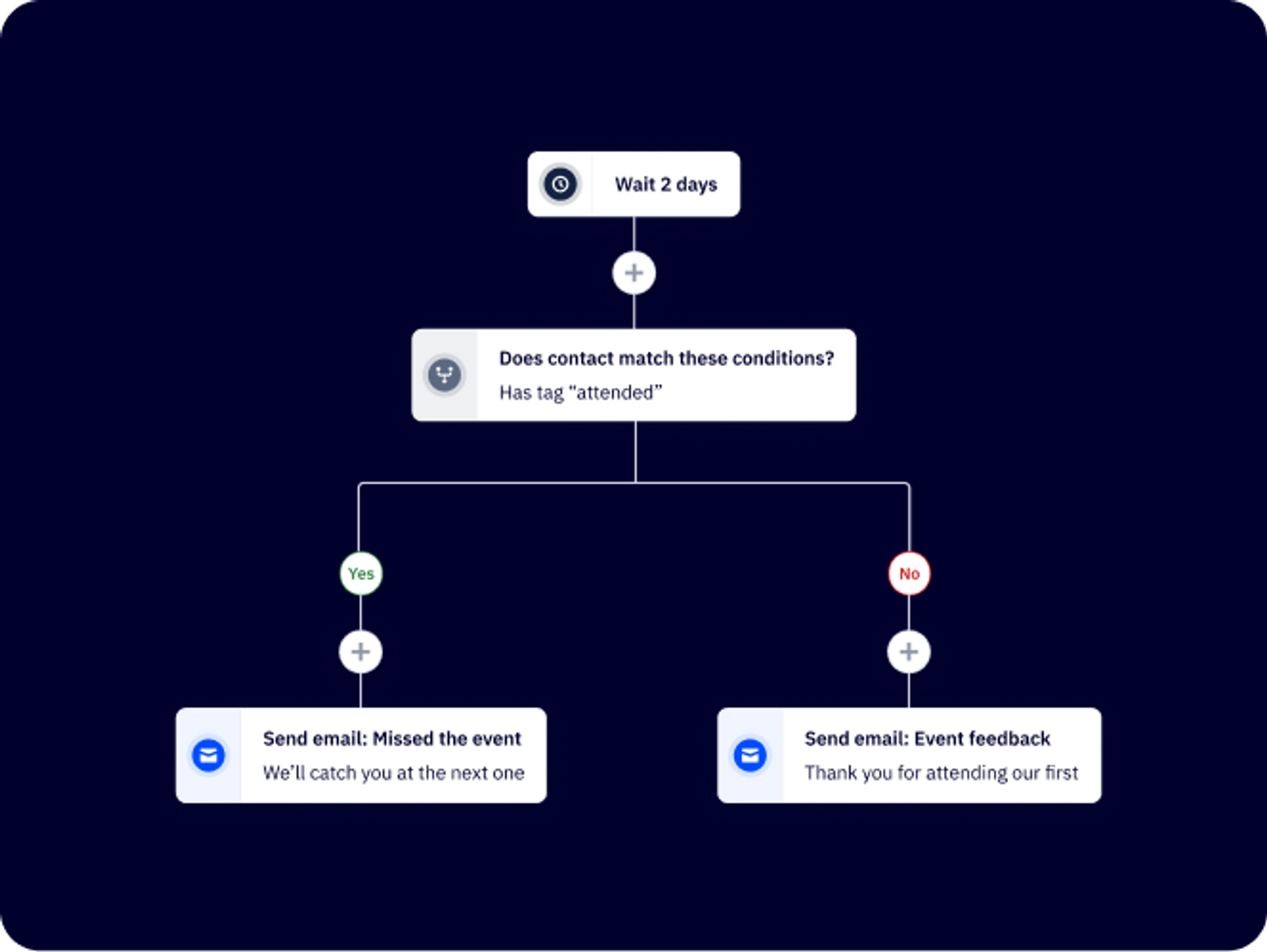
For example, new subscribers could see a welcome message, while longtime customers get a loyalty discount. It’s one email, but it feels tailor-made for everyone.
With ActiveCampaign’s conditional content, you can personalize specific sections of an email based on each contact’s data or behavior. For instance, if a customer has shown interest in a particular product category, you can set the email to display relevant product recommendations just for them.

This means different subscribers can see tailored messages, images, or offers in the same email based on criteria like past purchases, location, or engagement level. It’s a powerful way to ensure each contact gets a message that feels uniquely relevant to them, boosting engagement.
GetResponse also offers a solid lineup of email marketing features to help you create targeted, engaging campaigns.
Similarly to ActiveCampaign, their segmentation tools allow you to organize your audience into smaller, targeted groups based on demographics, behavior, or preferences. For example, you can create segments for new subscribers, repeat customers, or people who clicked on a specific link.

Dynamic segmentation isn’t available on their entry-level tier, only on the Marketing Automation plan and above.
You can also use A/B testing to test subject lines, email content, or even send times to see what works best with your audience. By comparing performance, you can refine your strategy to consistently improve open and click-through rates.
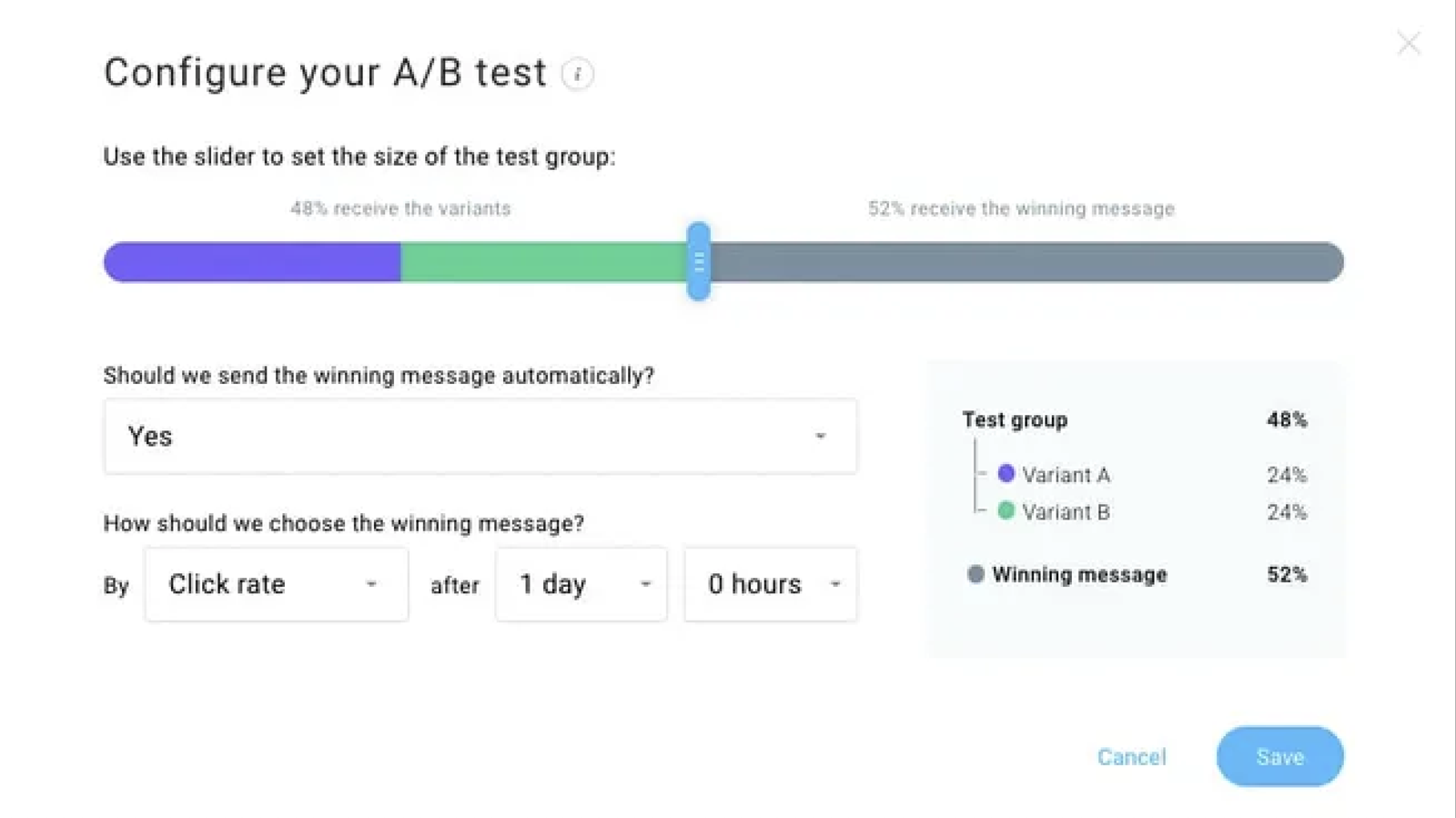
GetResponse does offer some level of dynamic content, but it’s not as advanced as what you’d find on other platforms. You can personalize sections of an email based on customer data, such as inserting their name or suggesting products related to their past behavior. It’s a good feature for basic personalization, though it doesn’t handle complex scenarios.
They also don’t offer full-fledged conditional content. However, you’ll still be able to use automation workflows to set up rules that send specific emails based on triggers like actions or behaviors. While not embedded within a single email, these workflows achieve a similar result by tailoring content to each customer’s journey.
It’s important to note that the majority of automation features don’t become available to you unless you choose the Marketing Automation plan or above. Only simple automations like welcome, thank you, and birthday emails are accessible on the Email Marketing plan.
ActiveCampaign offers multi-step automation in all of their plans.
Where GetResponse shines is with its e-commerce tools like abandoned cart triggers and product recommendations.
Abandoned cart emails help you recover potential lost sales by automatically reminding customers about items they left behind. Product recommendations let you highlight items based on a customer’s browsing or purchase history, which is great for personalizing emails and encouraging repeat purchases.
With these features, GetResponse strikes a balance between being user-friendly and offering tools to create effective, personalized campaigns. It’s particularly well-suited for small to mid-sized businesses looking to engage their audience with targeted email marketing.
Advanced automation vs. basic features
ActiveCampaign’s automation capabilities are incredibly advanced but simple to use. They provide hundreds of "automation recipes" you can use right out of the box and customize with your own tags, custom fields, and content. This means you can easily follow up with customers post-purchase, re-engage those who’ve abandoned carts, or send time-sensitive emails.
Their visual automation builder makes it easy to see complex workflows. You can add actions like “wait,” “if/then” logic, and triggers to shape each contact’s path.

This allows for conditional flows based on specific behaviors, like page visits or specific clicks, making it perfect for in-depth customer journeys. These workflows can include emails, SMS, site messages, and even CRM updates, all from one platform. It's perfect if you're managing both marketing and sales processes since it’s built to handle everything from lead nurturing to post-purchase follow-ups.
ActiveCampaign also allows you to A/B/C/D/E test entire workflows to see which sequence performs better. You can test different email paths, timing, or messages and compare which version drives more engagement or conversions.

This allows you to continuously improve your automations by finding the most effective ways to guide users through the customer journey.
Triggers, actions, and goals are the brain behind ActiveCampaign’s automation. “Triggers” are the conditions that kick off a workflow—like when a lead signs up for a webinar or reaches a certain score in your system. “Actions” are what the system does in response, such as sending a welcome email, tagging the contact, or moving them into a new list. “Goals” let you set milestones within workflows, like getting a contact to register for an event.
ActiveCampaign’s site tracking features let you see what your leads and customers are doing on your website. It records actions like page visits and button clicks, so you know which content or products are catching their interest.

Event tracking takes it a step further by tracking specific behaviors you define, like when a customer completes a purchase or fills out a form. This tracking gives you insights to tailor follow-up emails and other interactions based on real-time behavior.
Finally, their sales routing helps you make sure the right sales rep connects with the right leads. Based on factors like the lead’s location, behavior, or score, ActiveCampaign can automatically assign them to a specific rep. This feature helps keep leads from slipping through the cracks and ensures that your team’s follow-ups are fast and organized, which is especially helpful for businesses with high lead volumes.
All of these features make it easy to automate personalized experiences and ensure that both marketing and sales stay aligned, giving customers a smooth, well-timed experience with your brand.
ActiveCampaign offers the following features that GetResponse does not:
Lead scoring, e-commerce automation, split and conditional automations, automation goals, dynamic content, predictive sending, and 900+ automation recipes
Plus, ActiveCampaign comes with powerful AI features like generative AI content creation, an AI-powered automation builder, the AI Brand Kit, and AI-suggested segments.
GetResponse offers a variety of marketing automation features but some of them aren’t accessible on the entry-level plan and they’re not as powerful as other platforms.
GetResponse covers basic automations like welcome emails, thank-you emails, and birthday messages. These are great for establishing a connection with your audience and keeping them engaged at key moments.
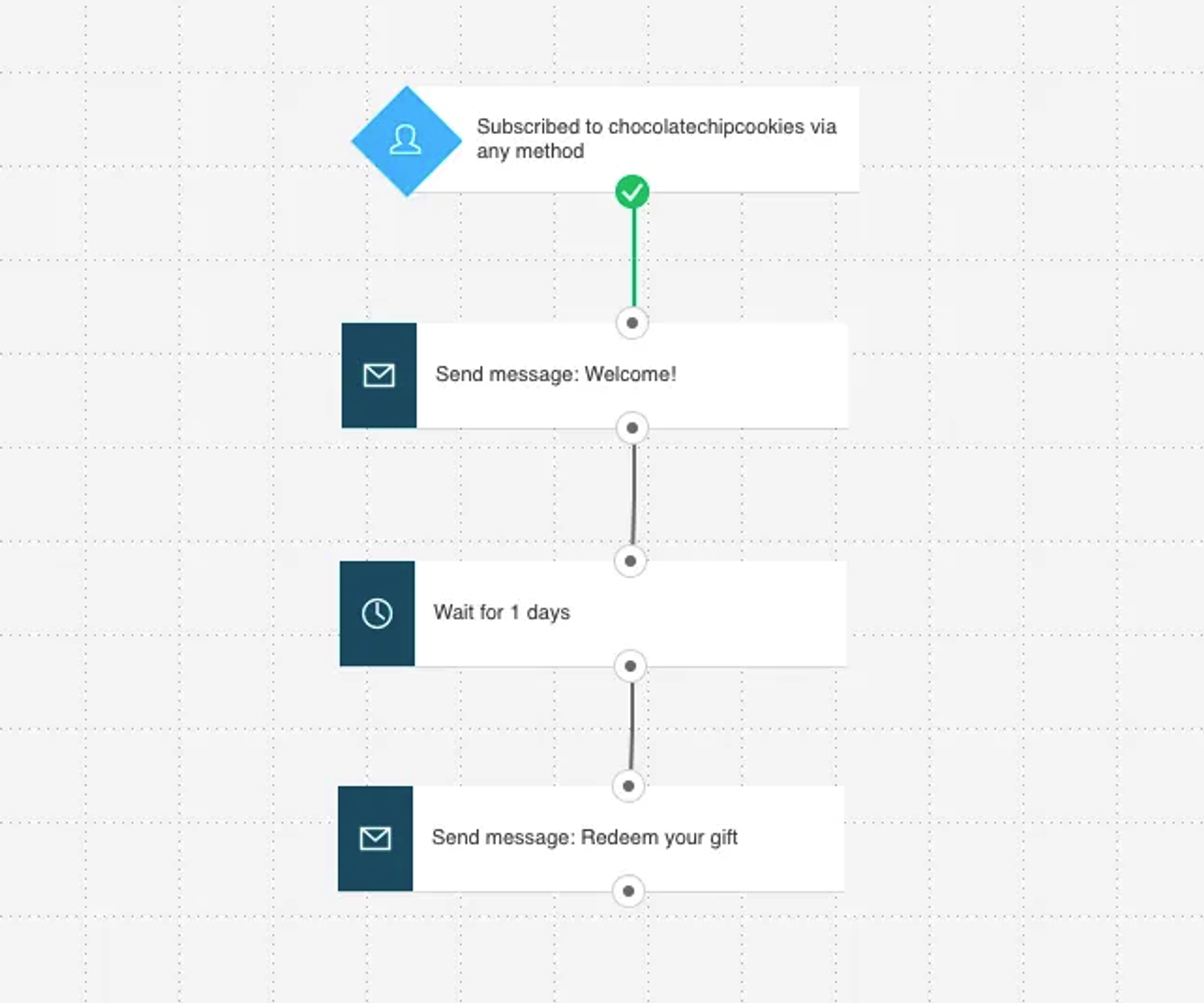
For example, you can automatically greet new subscribers, send a personalized thank-you after a purchase, or delight customers with birthday discounts—all without lifting a finger.
GetResponse also comes with pre-built automation templates. These templates cover common workflows like lead nurturing, abandoned cart recovery, and upselling. They’re a huge time-saver and make it easier to launch effective automations without having to create everything from scratch.
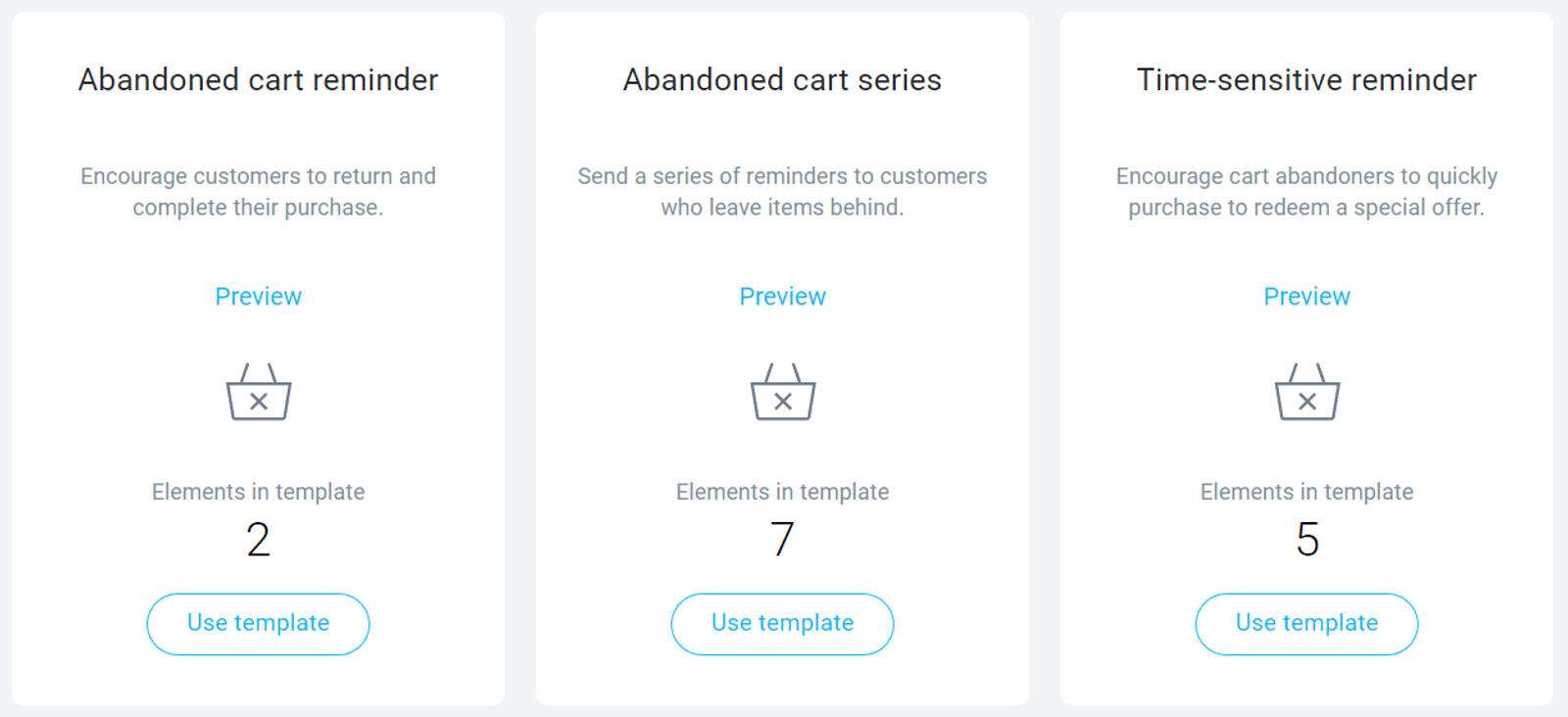
You can create follow-up emails based on whether someone clicked a link or opened a previous email. If a contact shows interest by clicking on a specific product, for example, you can automatically follow up with a discount or additional product details. This ensures you’re engaging with your audience at the right time with relevant content.
Tagging in GetResponse allows you to label contacts based on their actions or characteristics. For instance, you can tag someone as “Webinar Attendee” or “Interested in Product A.” These tags make it easy to segment your audience and send targeted campaigns that match their specific interests or behaviors.
GetResponse offers engagement scoring, a feature that lets you assign points to contacts based on their interactions with your emails, website, or campaigns. This is especially useful for identifying your most engaged leads or segmenting audiences by their readiness to convert. It’s a great tool for prioritizing follow-ups and focusing on high-value contacts.
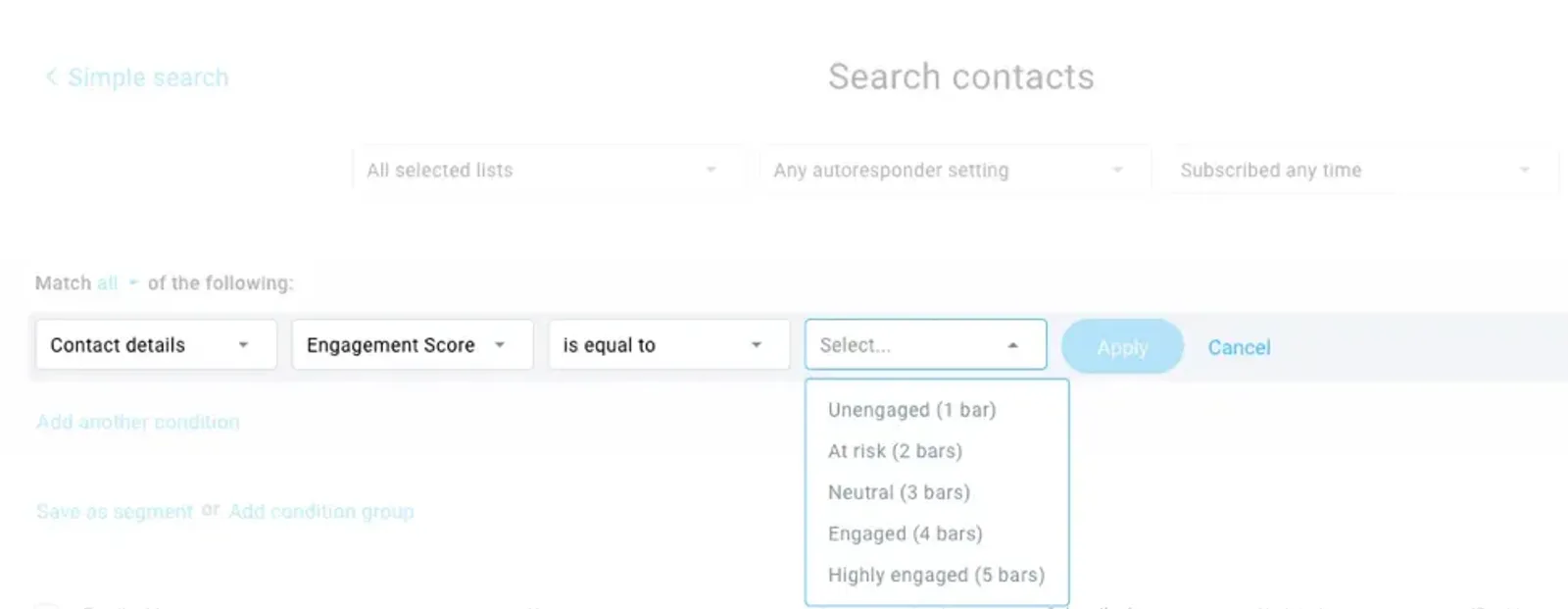
Split automation allows you to test different paths in your automation workflows. For example, you can send one group down Path A with a specific email series and another down Path B with a different sequence to see which performs better. This helps you optimize your strategies for maximum impact.
Contact tagging, engagement scoring, and split automations are only available on the Marketing Automation plan and up.
Unfortunately, GetResponse doesn’t offer advanced site and event tracking. While you can track email behavior like opens and clicks, its website tracking capabilities are limited. If detailed site tracking is a priority for you, this might be a limitation to consider.
Overall, GetResponse’s automation tools are perfectly capable of building personalized customer journeys, nurturing leads, and engaging your audience with relevant content. If you’re looking for more advanced features to build complex workflows, other platforms may be a better fit.
Integrated CRM for sales and marketing vs. marketing-focused CRM
ActiveCampaign’s integrated CRM is designed to bridge the gap between marketing and sales, offering an integrated solution that enhances both lead management and customer relationship efforts.
Contact management is central to their CRM, allowing you to store and organize customer data in a central location. You can track each contact’s interactions, purchases, and engagement with your emails or website. Plus, custom fields let you capture specific information about each contact, which helps tailor your communication and create more personalized experiences.
A standout feature of ActiveCampaign’s CRM is its sales automation. With automation, you can set up triggers that respond to a contact’s actions, such as opening an email or filling out a form. This helps you create automatic follow-up emails, task assignments, or reminders.
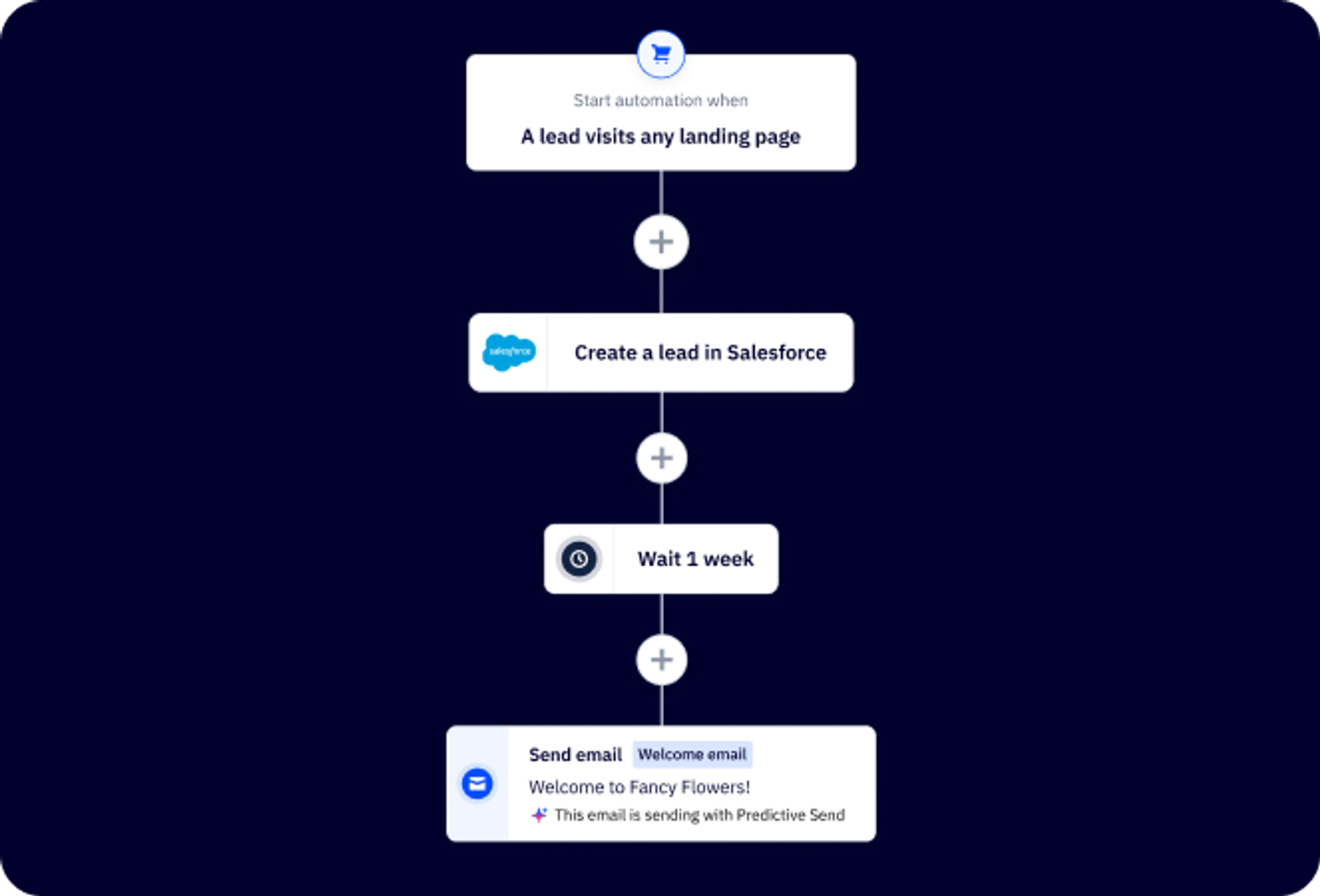
ActiveCampaign allows you to set up automated workflows for deal management, which means that when a lead takes a certain action—like submitting a form, opening a specific email, or clicking a link—they can automatically be assigned a deal status or even moved through different stages of the sales pipeline.

How you’d use it: Say a prospect fills out a request for a demo. You can set up an automation that automatically creates a new deal for that contact in your pipeline, assigns it to a salesperson, and sends them a notification.
By automating these steps, sales teams don’t have to worry about manually moving deals or assigning leads, which minimizes human error and ensures every lead is handled correctly.
Plus, you can use deal tracking and task management to keep your sales process moving smoothly. You can assign tasks to team members, set reminders, and track deal progress from start to finish. The activity timeline gives you a complete view of each contact's journey, including past communications, opened emails, and any sales activities. This level of detail is powerful for sales teams, ensuring they have all the information needed to close deals effectively.

ActiveCampaign also offers an extensive library of automation templates covering a wide range of marketing and sales needs, making it easy to get started with automated workflows. These templates are designed for common tasks like welcome sequences, lead nurturing, abandoned cart recovery, post-purchase follow-ups, win-back campaigns, and more.
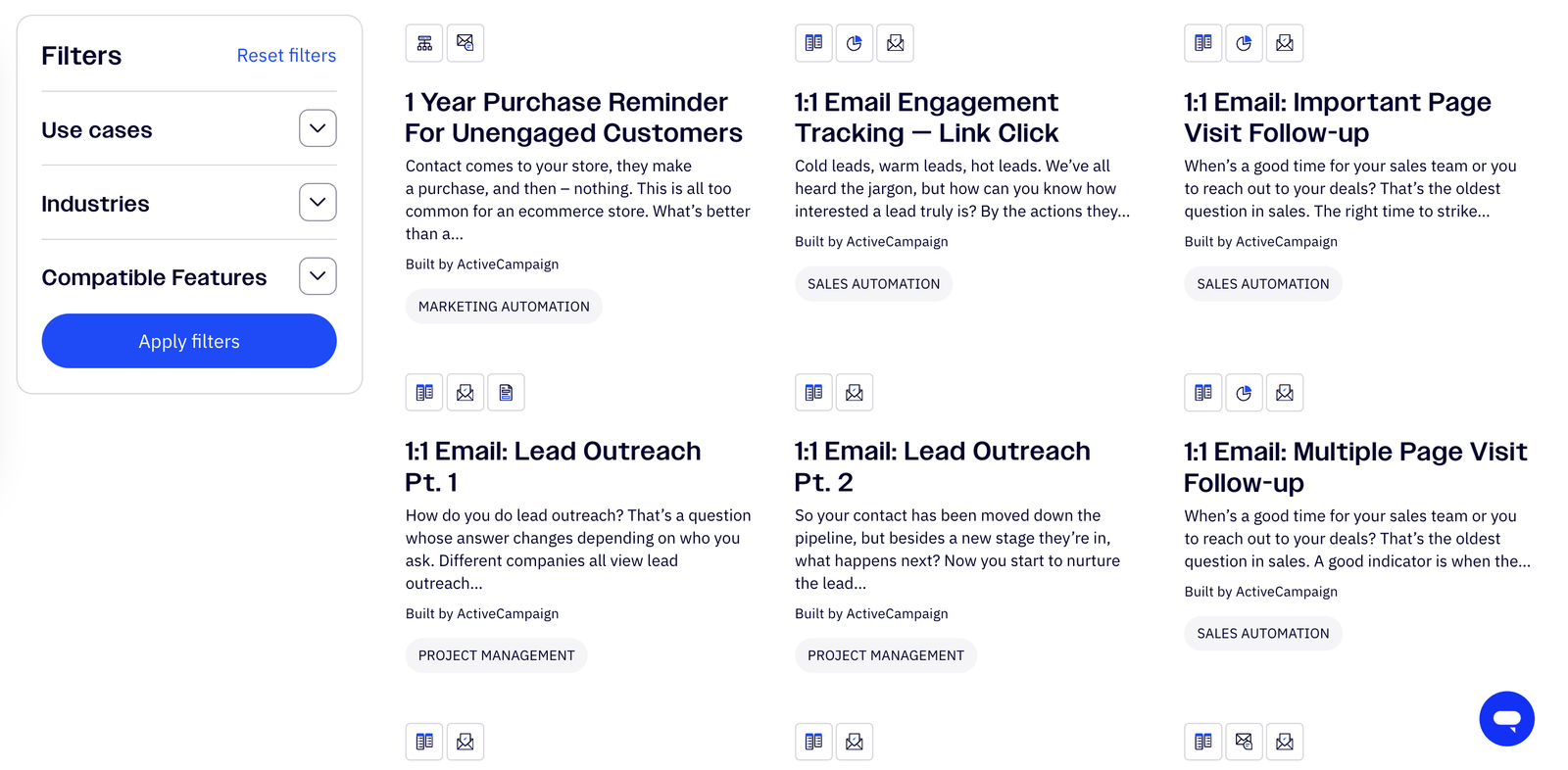
Each template provides a ready-made structure complete with suggested triggers, actions, and conditions, so you can quickly customize them to fit your specific goals.
For instance, the welcome email sequence template helps new subscribers get familiar with your brand, while the lead scoring template automatically assigns scores to contacts based on engagement, enabling you to prioritize leads. There are also templates for customer journeys that incorporate multiple channels (like email, SMS, and site tracking), which is useful if you’re aiming for a cohesive experience across different touchpoints.
Key features of ActiveCampaign’s CRM:
- Send a notification or Slack message when a contact’s information changes or they complete specific actions.
- Track and divide up the sales outreach process between different members of your team.
- Set up automations to send relevant content to your customers based on things like order size or response times.
- Use Kanban-style boards to visualize sales opportunities.
- ActiveCampaign’s lead scoring helps you find the most promising opportunities based on your prospects’ actions and behaviors.
- The deal scoring feature gives each of your deals a numerical value so you can understand which deals are a priority.
- Use automations to create and modify deals in the CRM based on the data you’ve already collected from each contact.
GetResponse does not offer a dedicated CRM system, but it features a conversion funnel tool designed to help businesses automate key marketing and sales processes.
The conversion funnel acts as a prebuilt, automated sales and marketing system to streamline your workflow. It combines tools like email automation, landing pages, and sales mechanisms into ready-made funnels for specific goals. Here are the main types of funnels offered:
- Opt-in funnels: Designed to capture leads using customizable landing pages and forms. They allow you to collect contact details and grow your email list effortlessly.
- Lead magnet funnels: These funnels help you share valuable content like e-books or guides to attract and nurture leads. It's an effective way to build relationships and establish trust.
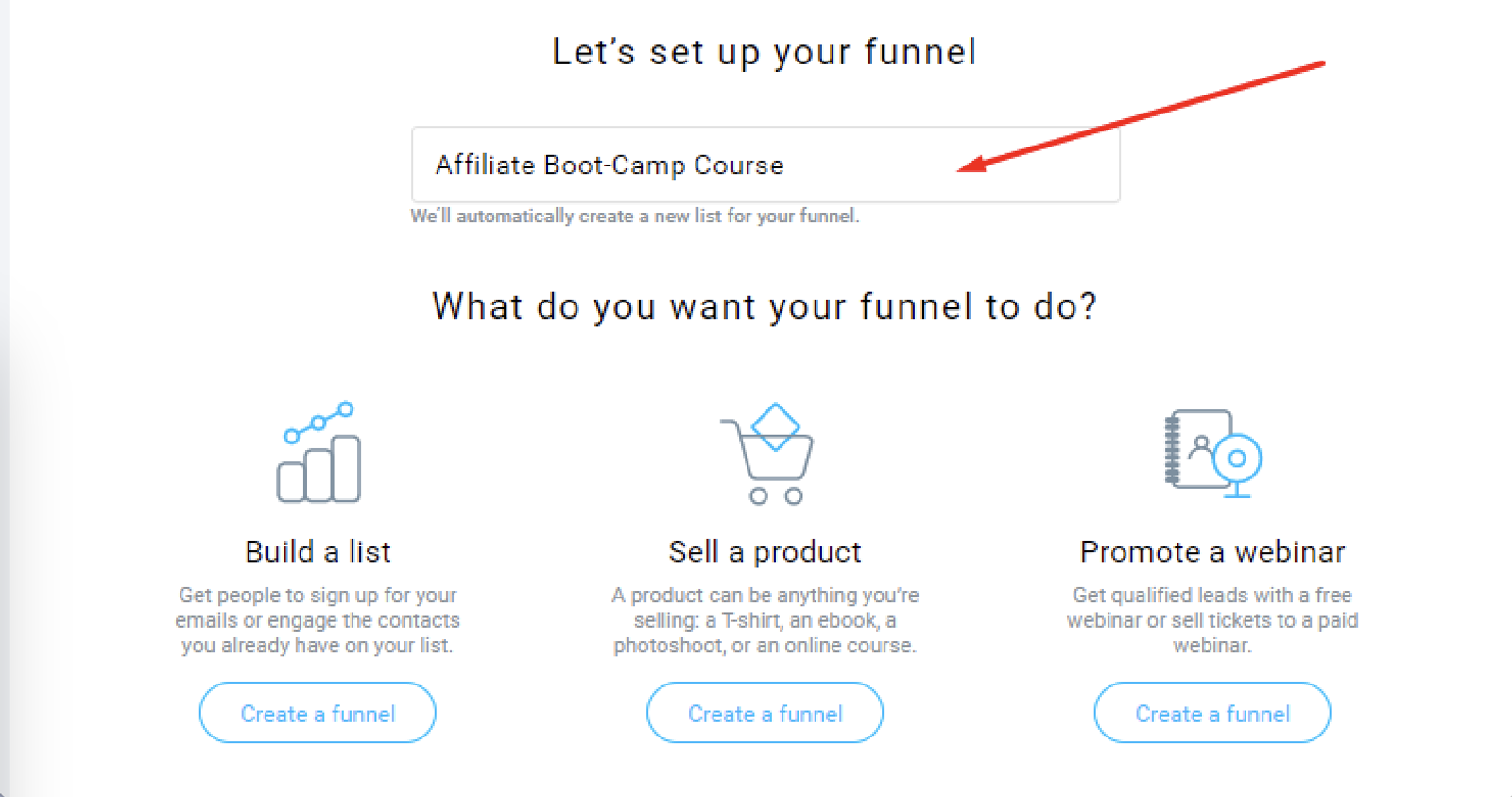
- Sales funnels: Create end-to-end paths to sell products online. These funnels help you promote your products, integrate payment options, and manage abandoned cart recovery to boost sales conversions.
- Webinar funnels: Ideal for hosting live or on-demand webinars, these funnels help you turn your expertise into revenue. They include tools to manage webinar registrations and follow-up emails.
While not a full-fledged replacement for an integrated CRM, GetResponse offers essential lead generation features to complement these funnels. We’ll go deeper on landing pages in just a minute.
- Forms and popups: Use these to capture leads directly from your website. They can be integrated into various funnel types to ensure a seamless user experience.
- Landing pages: Professionally designed templates are available to create visually appealing pages that drive lead generation and conversions.
It’s important to note that GetResponse lacks the advanced contact and sales management tools you’d find in a dedicated CRM. However, they are a great fit for businesses focused on email marketing and automated customer journeys.
Landing pages: both builders are powerful
ActiveCampaign offers solid lead generation tools integrated into its broader platform, including forms and hundreds of landing page templates. This ensures a smooth transition from lead capture to conversion, making the platform a solid choice for businesses that value an all-in-one approach.
ActiveCampaign’s landing page builder allows you to create highly customized landing pages. It comes with a drag-and-drop editor and the power to build pages that include conditional content and integrate seamlessly with your CRM data.

This means you can personalize landing pages based on user behavior and contact information, which is great for targeted campaigns.
In general, ActiveCampaign’s builder provides great flexibility by providing deeper customization options and more advanced features. You can create highly tailored landing pages that integrate with your automations and incorporate dynamic content that will change based on who’s viewing the page. This dynamic content is not available with GetResponse.
The builder offers a wider range of design options, including custom code, advanced styling, and more control over layout elements. Additionally, ActiveCampaign supports more advanced A/B testing and analytics directly tied to your email and automation campaigns, giving you a more comprehensive view of how your landing pages perform.
Key features of the ActiveCampaign landing page builder:
- Quickly collect opt-in information from leads
- Add forms to your page and generate qualified leads
- Broaden your reach with ActiveCampaign’s landing page design service (complimentary for accounts on the Plus, Professional, and Enterprise plans)
- Add automations to kick off lead nurturing based on form submission, registering for an event, or making a purchase
GetResponse offers a solid set of features for landing page creation. To start, their drag-and-drop builder allows you to easily design landing pages without needing coding knowledge.

The builder is user-friendly, so even beginners can create professional-looking pages quickly. However, if you're an experienced designer looking for advanced customization options, you may find some limitations in terms of flexibility and detailed control over the design.
The platform offers a wide variety of templates to suit different goals, from lead capture to product promotion. These templates are designed to be easily customizable, so you can adjust elements like text, images, and forms to align with your brand.
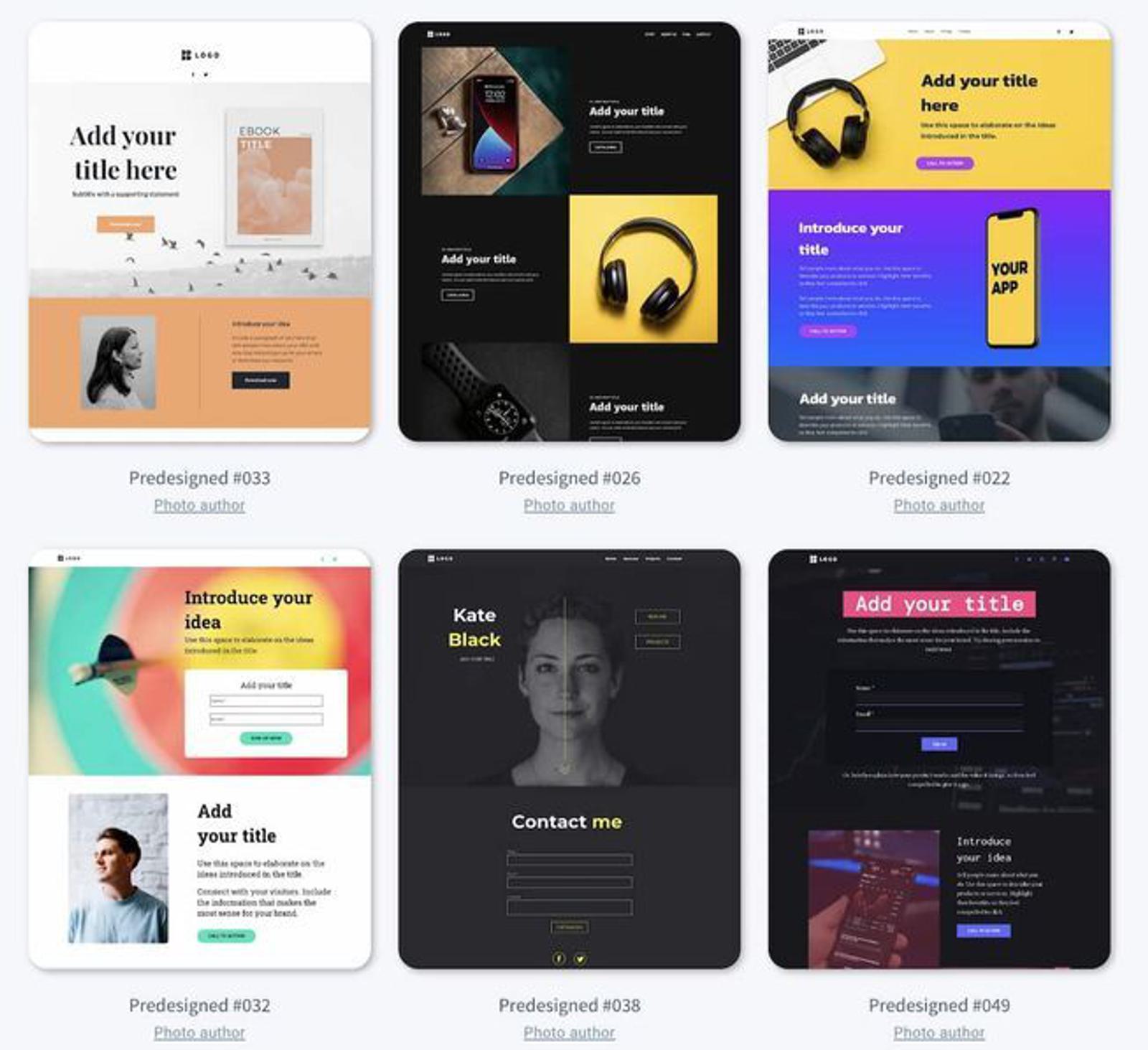
GetResponse also includes A/B testing capabilities for landing pages, which allows you to compare different versions of a page to see which performs better. This is a valuable tool for optimizing your landing pages and improving conversion rates by testing variations in copy, design, and layout.
Plus, all pages are mobile-responsive, crucial in today’s mobile-first world.
Keep in mind: While ActiveCampaign offers landing pages, theY are only available on the Plus plan and up. In contrast, GetResponse includes landing pages on all of its plans, although the number of landing pages you can create is limited to just one on the lowest-tier plan.
Overall, GetResponse’s landing page features are ideal for businesses looking for key functionalities like A/B testing, mobile optimization, and e-commerce integrations. While it may lack some of the deeper customization options that experienced designers might want, it's a solid choice for those looking to create effective landing pages quickly.
Comprehensive reporting vs. bare-bones reporting
The biggest difference between ActiveCampaign and GetResponse’s reporting features is how detailed the insights are and the types of metrics you can track.
ActiveCampaign offers a range of reports that give you deep insights into your marketing campaigns. One that stands out is the Marketing Revenue Report, which ties your marketing efforts directly to revenue.
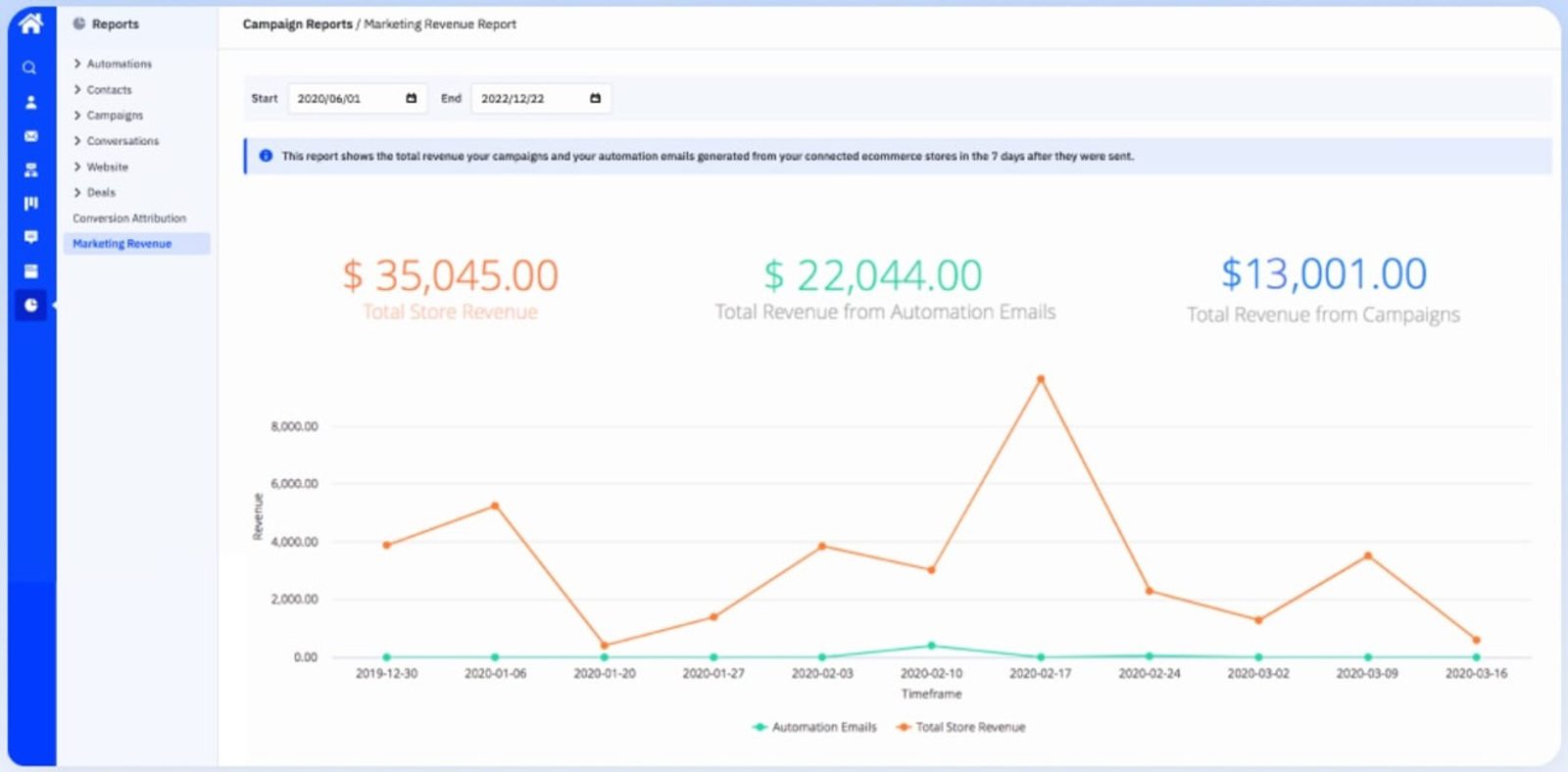
ActiveCampaign’s Marketing Revenue report helps you directly link your marketing activities to actual sales, giving you a clear picture of your ROI, a view of what’s working, and where you might need to make adjustments.
ActiveCampaign’s other report types include:
- Campaign performance reports: After sending out a new email campaign, you can use ActiveCampaign's reporting tools to quickly analyze its performance. For example, if you notice a high open rate but a low click-through rate, this data can help you adjust your subject lines or calls to action for future emails. It's perfect for real-time adjustments when you're testing different messages or promotions.
- Automation reports: If you're running an automation sequence, such as an onboarding flow for new customers, you can track how each step performs. If you find that users are dropping off after the second email, you can tweak the messaging or timing. These insights allow you to refine your strategies on the fly to improve conversion rates.

- Custom reports: Say you're interested in how specific segments of your audience (like repeat customers) interact with your emails. ActiveCampaign allows you to create reports tailored to those groups so you can dive deep into behavior patterns, optimize content for them, and track specific engagement metrics like purchase behavior.
- Real-time data: You can track the performance of an email campaign immediately after launch. This feature is ideal for marketers who want to see how their audience reacts to a particular offer and make necessary adjustments, like adjusting send times or follow-up sequences.
Key features of ActiveCampaign reporting:
- Use first-party data and ActiveCampaign’s industry expertise to score your performance and determine next steps.
- Filter out unreliable metrics and click fraud to ensure data accuracy.
- Use ActiveCampaign’s real-time reporting toolkit to spot trends, find new opportunities, and uncover actionable data about your customers.
- Predict how likely a deal is to close with win probability.
- Bring data in or send data to any app with over 970 integrations.
Looking at GetResponse, you’ll get some basic reporting features to help you track how your email campaigns are performing but they’re not going to yield the most detailed or advanced insights.
In the analytics tab, you can see essential metrics such as how many contacts opened, clicked, bounced, subscribed, or unsubscribed from your emails.
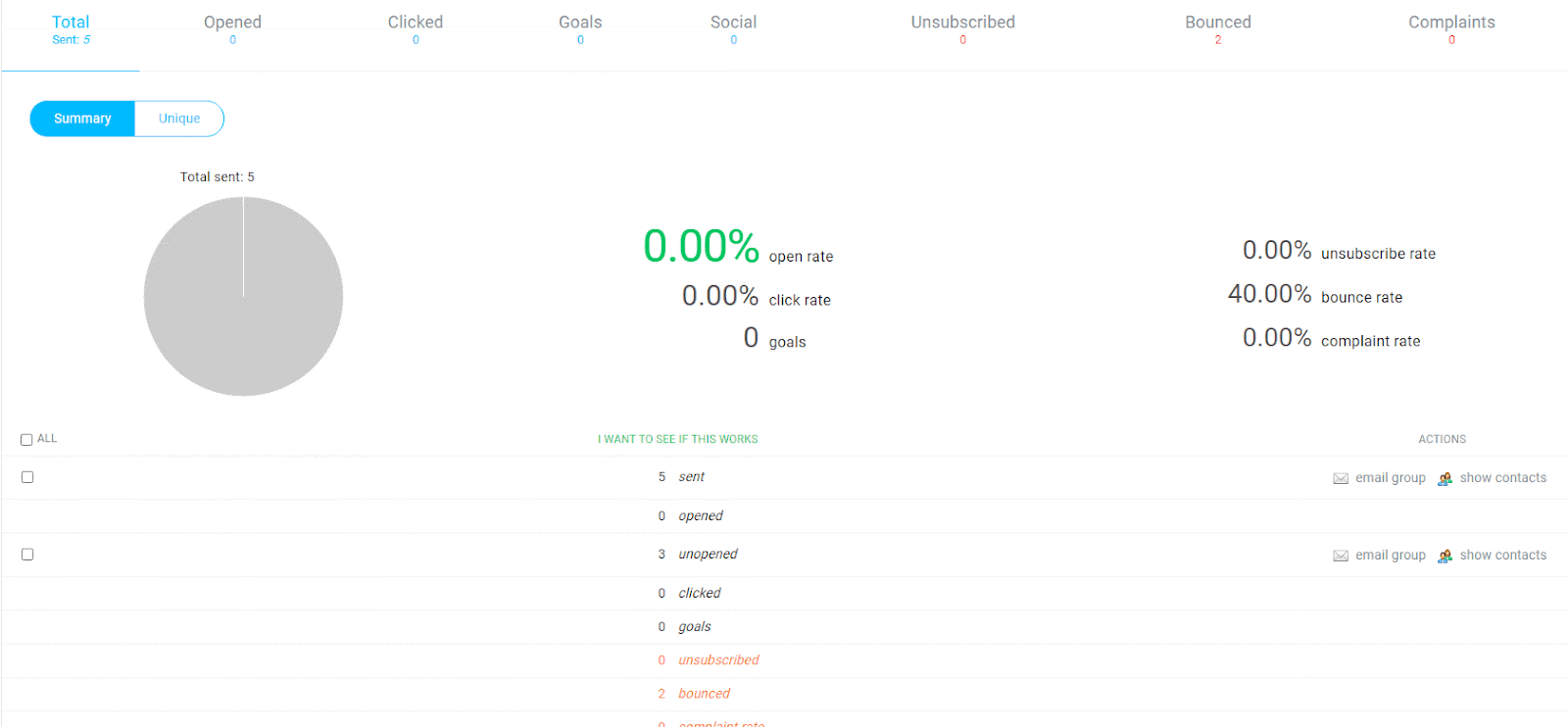
While these are important stats, they mostly give you surface-level insights, meaning they’ll show you trends but won’t necessarily help you dive deeper into user behavior or engagement patterns. You can see basic performance numbers, but there’s not much beyond these core metrics to help with in-depth analysis or long-term strategy adjustments.
One interesting feature GetResponse does offer is a clickmap. This tool lets you track where your users click within an email, giving you a visual overview of which areas get the most attention.

It’s a handy feature for understanding how readers interact with your content and can be useful for optimizing your email layout.
If you're running an e-commerce business, GetResponse does have an e-commerce report that tracks important metrics like order history, average order value, revenue, and product recommendations. While this is useful for getting a basic sense of how your online sales are performing, it’s still fairly limited in its depth and granularity.
GetResponse's reporting tools cover the basics but don't provide deep or comprehensive data that would allow for truly smart, data-driven decisions. If you're looking for more detailed insights into customer behavior, email campaign optimization, or advanced e-commerce analytics, you'll find that GetResponse’s reporting falls short compared to other platforms.
Integrations: 970+ vs. 185
In ActiveCampaign’s app marketplace, you’ll find 970+ apps that integrate with various tools and platforms, including CRM systems, e-commerce platforms, and other popular marketing tools. It supports connections with Salesforce, Shopify, WooCommerce, BigCommerce, Asana, and hundreds more.
GetResponse offers substantially fewer integrations, just 185. Still, they have a slew of e-commerce integrations like Shopify, BigCommerce, and WooCommerce, plus popular tools like Squarespace, Google Analytics, Zapier, and more.
The platform that’s right for you will ultimately come down to which tools you’re already using and if ActiveCampaign or GetResponse can easily integrate with them. By and large, ActiveCampaign offers more flexibility and power when connecting all your apps together (which makes every function a lot easier).
Support and onboarding: a tie
Both platforms offer a variety of support channels.
ActiveCampaign provides 24/7 live chat and email support on all plans, ensuring you can get help whenever you need it. Their extensive resource library includes webinars, detailed guides, and a community forum offer a wealth of information to help you navigate and optimize your experience as you switch to and begin using the platform.

One-on-one virtual onboarding sessions are available on all ActiveCampaign plans. The first session will focus on your business’ goals and an onboarding team member will show you exactly how ActiveCampaign automation can benefit you and your bottom line.
You’ll be able to migrate up to a number of objects (based on your plan), including lists, templates, automations, forms, and landing pages.
GetResponse offers email and live chat support but it’s not 24/7. They have a knowledge base available for anyone who prefers reading guides to help resolve issues. Phone and Slack support, dedicated onboarding, and a dedicated customer experience manager are available with GetResponse’s MAX plan.
Pricing breakdown
Both ActiveCampaign and GetResponse have similar pricing structures. Still, there are some differences you should note when selecting the plan that will work best for you.
GetResponse pricing
GetResponse offers a free plan, but it’s pretty limited to one user and has a range of features that are suitable for any who needs basic newsletter and email-sending functionality.

The GetResponse free plan includes:
| Newsletters | A visual email editor |
|---|---|
| 2,500 monthly email sends | No integrations or reports |
| Custom DKIM | Click tracking |
| Custom HTML | Import of contacts |
| Signup and contact forms | Limit of one popup form |
| Contact importing | Click tracking |
| SEO settings |
If your needs go beyond a simple newsletter, GetResponse’s entry-level pricing starts with the Email Marketing plan, costing $19/month for up to 1,000 contacts.
With the Email Marketing plan, you have access to the following features:
| Unlimited monthly email sends | Google Analytics tracking | Pre-designed templates |
|---|---|---|
| HTML editor and custom HTML | Removal of GetResponse branding | Basic automation templates |
| A/B testing | RSS-to-email | Scheduling |
| Email and chat support | Segmentation based on basic contact criteria | Pre-designed website templates |
| AI email generator | Autoresponders | Reports |
| Website builder | Unlimited subpages | Unlimited landing pages |
| 1 active website and Gallery | Unlimited pages and visitors | Contact, signup, and popup forms |
| SSL security | Website chat | SEO settings |
| Predesigned landing page templates | Integrations (excluding Microsoft Dynamics) | E-commerce stores and products center |
| Lead funnels and lead magnet funnels | Google and Facebook Ads |
The next tier is the Marketing Automation plan which will cost you $59/month for only 1,000 contacts and 3 users.
With the Marketing Automation plan, you have access to everything mentioned, plus:
| Build from scratch automations | Click and open follow-ups |
|---|---|
| Drip campaigns | Split automation |
| Contact tagging and scoring | Event-based automation |
| Limited push notifications | Dynamic segmentation |
| Role management | List scoring |
| Segmentation based on scoring and events | Payment gateway integration |
| 5 active websites | Webinar funnels |
| Up to 100 webinar attendance | 3hr recording storage and 3 presenters |
| Custom opt-in prompt | GetResponse Chat |
| Sales funnels | Newsletter revenue statistics |
GetResponse’s next tier is aimed at e-commerce businesses and will cost you $119/month for only 1,000 contacts. With it, you get typical e-commerce features like abandoned cart recovery, product recommendations, and e-commerce tracking.
The E‑commerce Marketing plan comes with everything mentioned, plus:
| 5 users | Purchase automation |
|---|---|
| Promo codes: all unique and synced | Unlimited send push notifications |
| Segmentation based on e-commerce | Abandoned order recovery |
| Transactional emails | E-commerce reports |
| Order confirmation automation | Up to 300 webinar attendance |
| 6hr recording storage and 3 presenters | Web push notification scheduling |
| Recommendations reports |
Finally, GetResponse’s MAX plan is aimed at enterprise-level businesses with custom solutions and premium features. The plan will cost you $1,099/month.
With the MAX plan, you get these additional features:
| SMS marketing automation | Phone support | Dedicated IP |
|---|---|---|
| Unlimited number of accounts and users | Dedicated customer experience manager | Slack support (for selected MAX customers) |
| Dedicated sending domain | Single sign-on (SSO) | Rebranding options |
| Dedicated onboarding | Development strategy support | 10 active websites |
| Segmentation based on SMS action | Segmentation based on external segments | Performance analytics for transactional emails |
| Mobile push notifications | Triggered emails | API and SMTP connection |
| Transactional email sending history | Up to 1000 webinar attendance | Up to 20hrs of recording storage |
| Webinar breakout room option | 500 GetResponse Chat seats |
ActiveCampaign pricing
Compared to similar enterprise-level automation tools like HubSpot or Salesforce, ActiveCampaign is pretty budget-friendly for the features you get. They don’t offer a free plan (just a free two-week trial), but their Starter plan gives you access to some pretty advanced features for only $15/month.

Prices above are based on a max of 1,000 contacts.
ActiveCampaign’s entry-level pricing starts at $15/month for 1,000 contacts. This plan, aptly named the Starter plan, gives you access to multi-step marketing automation right out of the gate.
With ActiveCampaign’s Starter plan, you get access to features like:
| Email sends 10x contact limit | Email campaigns and newsletters |
|---|---|
| 5 actions and triggers per automation | Basic and inline web forms |
| Over 250 email templates | An AI-powered automation builder |
| A/B testing on emails | Limited segmentation |
| The ActiveCampaign Marketing CRM | Over 970 integrations, including standard e-commerce apps |
| Limited reporting and analytics | And site tracking |
| 900+ automation recipes |
Moving up to the Plus plan, you unlock more automation and powerful customer insights for $79/month with 1,000 contacts.
The Plus plan adds features like:
| Unlimited triggers and actions for your automations | Prospecting and retargeting ads for Google, Facebook, and LinkedIn |
|---|---|
| Web forms | Landing pages (and templates) |
| Generative AI functionality | Basic segmentation |
| Basic reporting and analytics | And revenue reporting |
With the Plus plan and up, you can add on the pipeline enhanced CRM to manage your sales automation or the sales engagement CRM that includes additional email and AI capabilities.
ActiveCampaign’s Pro plan will cost you $79/month with 1,000 contacts. With it, you unlock full omnichannel marketing automation. This is where you can truly elevate your email marketing. Your monthly email sends are 12x your contact limit, and you’ll get three users instead of one.
The Pro plan gives you access to additional features like:
| A/B testing on automations | Conditional content |
|---|---|
| Advanced segmentation, reporting, and analytics | Attribution and conversion tracking |
| Conditional content |
The Pro plan helps you get more granular about how your email campaigns are performing and understand what content, messaging, and offers move the needle for your business. You’ll have total control over your email cadence.
Finally, ActiveCampaign’s Enterprise plan starts at $145/month for 1,000 contacts and allows you monthly email sends 15x your contact limit plus five users.
With the Enterprise plan, you get everything previously mentioned, plus:
| Premium segmentation | Single sign-on (SSO) |
|---|---|
| Premium CRM integrations with Salesforce, Microsoft Dynamics, and more | Premium reporting and analytics |
| Custom objects | And a dedicated account team |
No matter which ActiveCampaign plan you choose, ActiveCampaign offers services like contact migration, customer enablement workshops, chat and ticket support, video tutorials, a knowledge base, and help guides to help you get the most out of the platform so you can focus on running your business.
ActiveCampaign or GetResponse: which is best for you?
The platform you choose will depend on which features above are most important to you (and which you need to grow your business).
Choose ActiveCampaign if you want to level up your marketing with advanced automation, personalized customer journeys, and a powerful CRM that scales as you grow.
Choose GetResponse if you’re looking for an all-in-one marketing platform with beginner-friendly email tools, pre-designed templates, and easy automation to kickstart your campaigns.
While GetResponse is a great choice for beginners with its user-friendly email tools and straightforward automation, ActiveCampaign stands out as the better option for businesses seeking advanced automation, personalized customer journeys, and powerful CRM capabilities that scale with you as you grow.
What are real customers saying about each platform?
Are customer stories too biased for you? We get it. Let’s look at a few reviews from real users.
| Pros: I love that so many of the features I want are in this one platform. The reason I switched to GetResponse was a combination of falling in love with the sales funnel functionality and the price. | Cons: I found that the sales funnel functionality is on their old website and doesn't seem to be a priority to update. Instead, they're adding a course platform but I'd love to see their current functionality updated before adding more. |
|---|
| Pros: We were able to roll AC out to our sales team. It was an easy transition thanks to a beautiful interface and endless education resources. ActiveCampaign is well suited to scale, too. It's small enough to be an easy on-ramp for a small company but can scale to any size. | Cons: I started on ActiveCampaign with a small company. I would have loved to get more included training or personalized deals pipelines to help get the ball rolling. Integration was incredibly easy, but I would have loved more help with getting started. |
|---|
Frequently asked questions
Lingering questions? We've got you.
💡 Who is ActiveCampaign best for?
ActiveCampaign is ideal for businesses that want to take their marketing to the next level with powerful automation and personalization features. It’s a great fit for small to mid-sized teams who need advanced tools to automate their marketing, segment their audience, and track detailed performance metrics.
If you're looking for a platform that offers deep customization, predictive analytics, and a visual workflow builder to create tailored customer experiences, ActiveCampaign could be a perfect match. It’s especially useful if you have a bit of experience with email marketing and want to leverage more sophisticated strategies to drive growth.
💡 Can ActiveCampaign be used as a CRM?
Yes, ActiveCampaign can be used as a CRM. It includes built-in CRM functionalities that allow businesses to manage their sales pipelines, track customer interactions, and automate follow-ups.
The combination of marketing automation and CRM in one platform helps simplify the sales process, improve customer engagement, and maintain organized records of customer data and interactions, making it easy to manage your marketing and sales in one place.
💡 Is GetResponse a CRM?
GetResponse isn’t a full CRM, but it does have some CRM-like features. It’s mainly an email marketing platform, but its tools for managing leads, tracking customer interactions, and organizing workflows make it handy for basic CRM needs. If you’re looking for something simple and all-in-one for marketing and light customer management, GetResponse could work well.
💡 Does ActiveCampaign integrate with my existing tools?
Yes, ActiveCampaign offers extensive integration capabilities with over 950 tools, including popular platforms like Shopify, WordPress, and Salesforce. Whether you need to integrate with e-commerce platforms, CRM systems, or other marketing tools, ActiveCampaign has a wide range of options to ensure all your existing tools are speaking to one another.